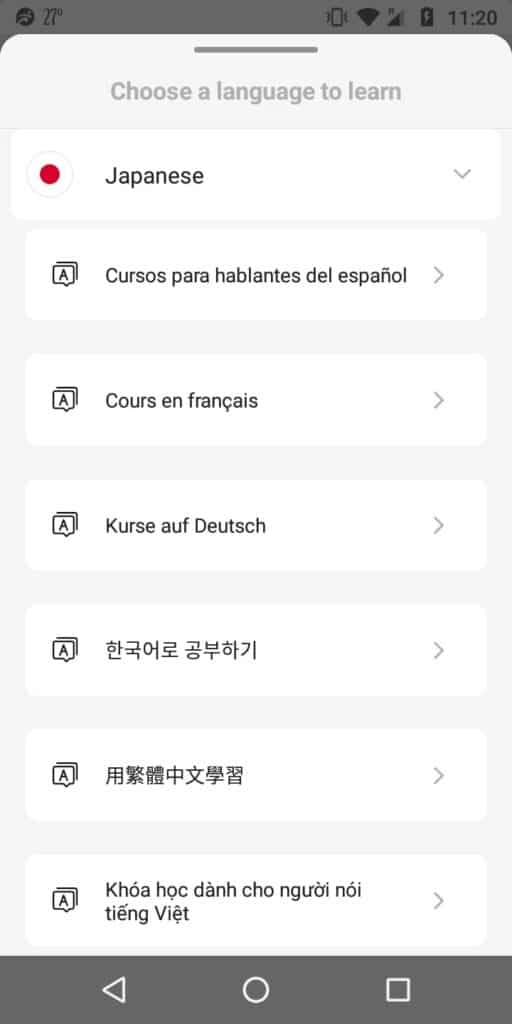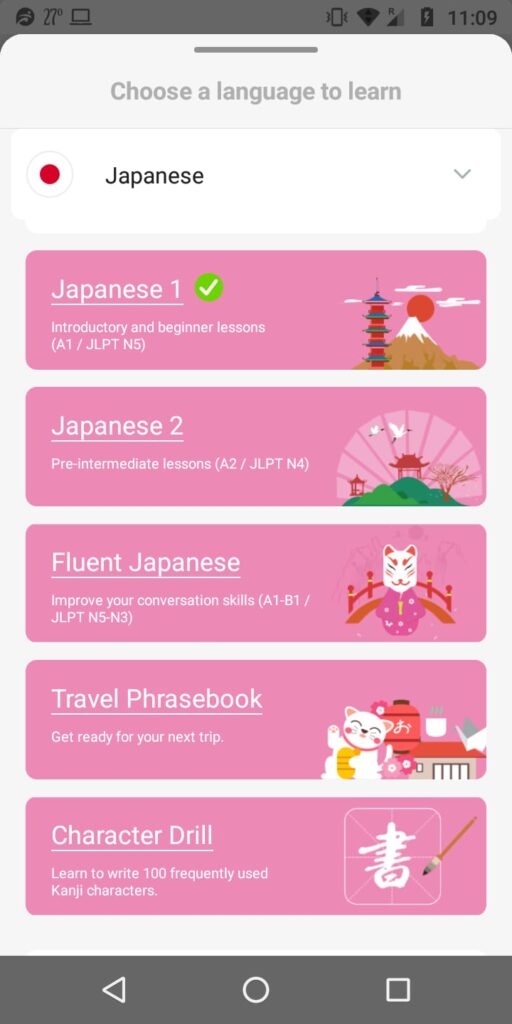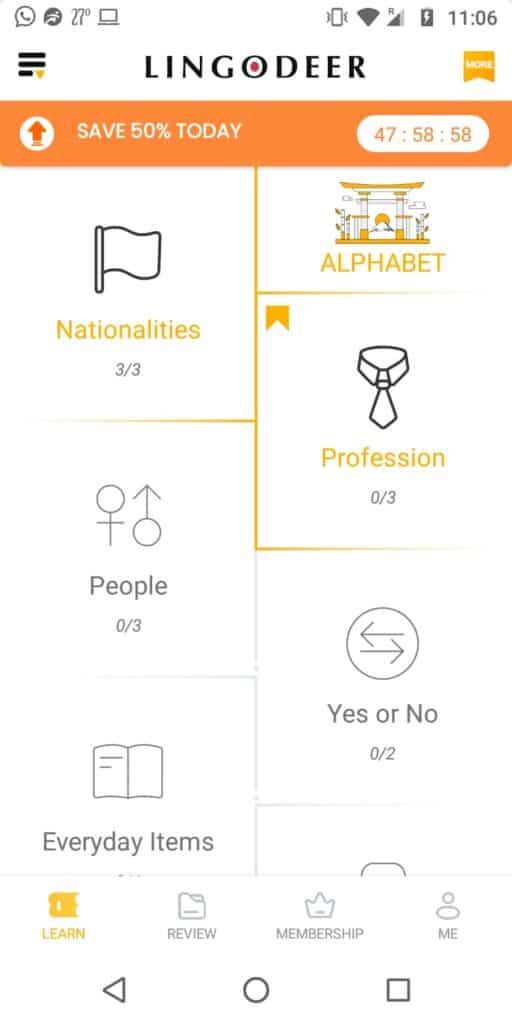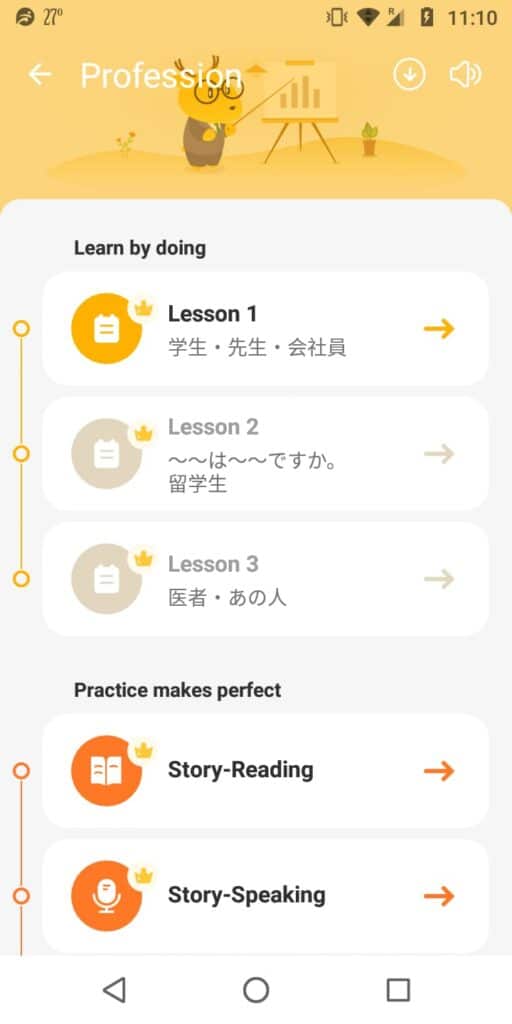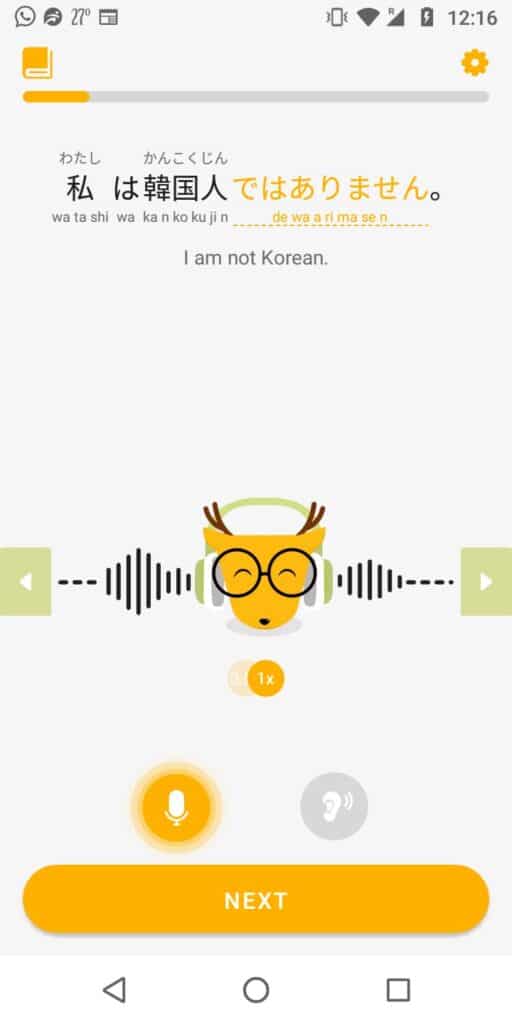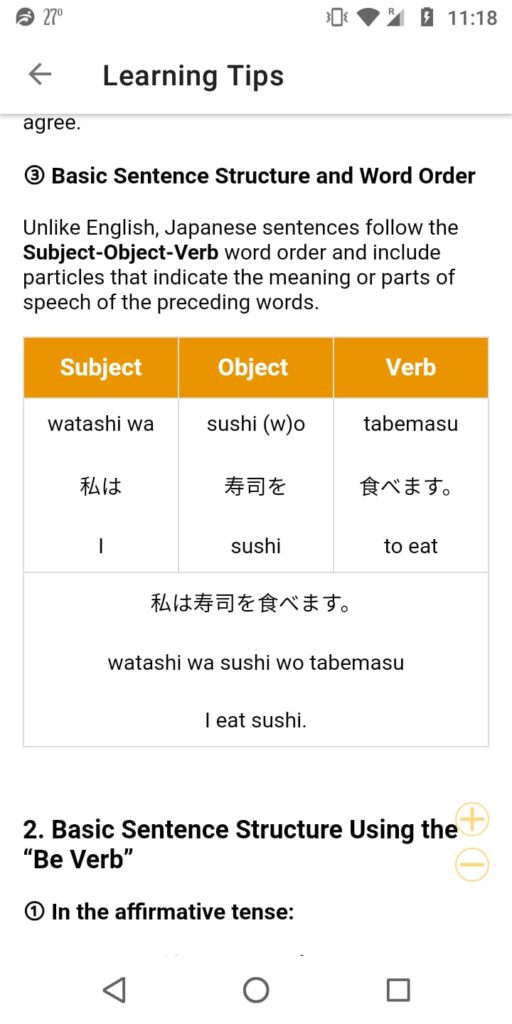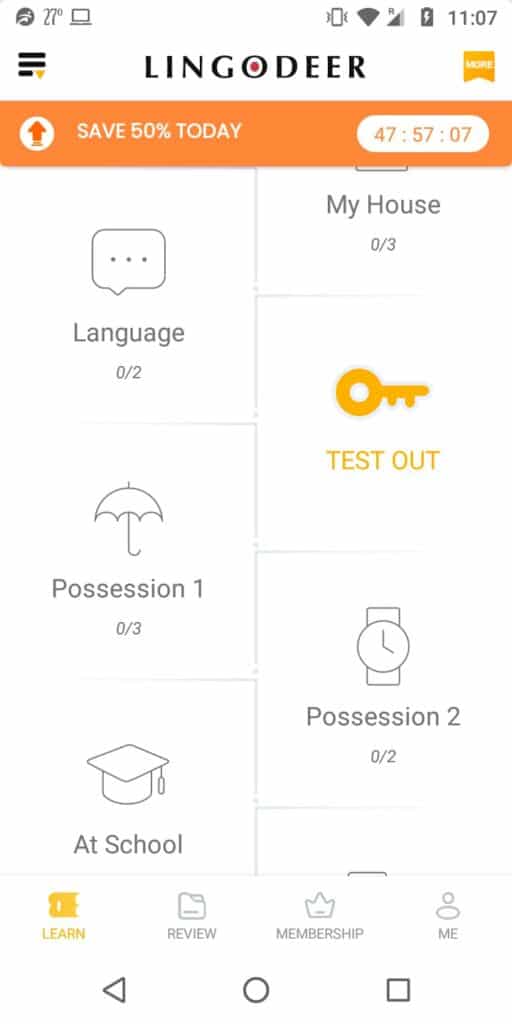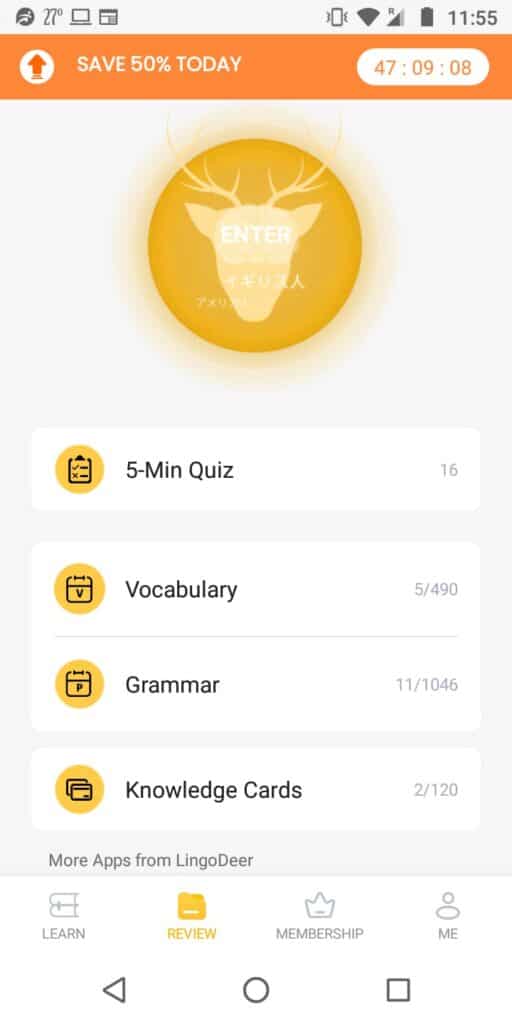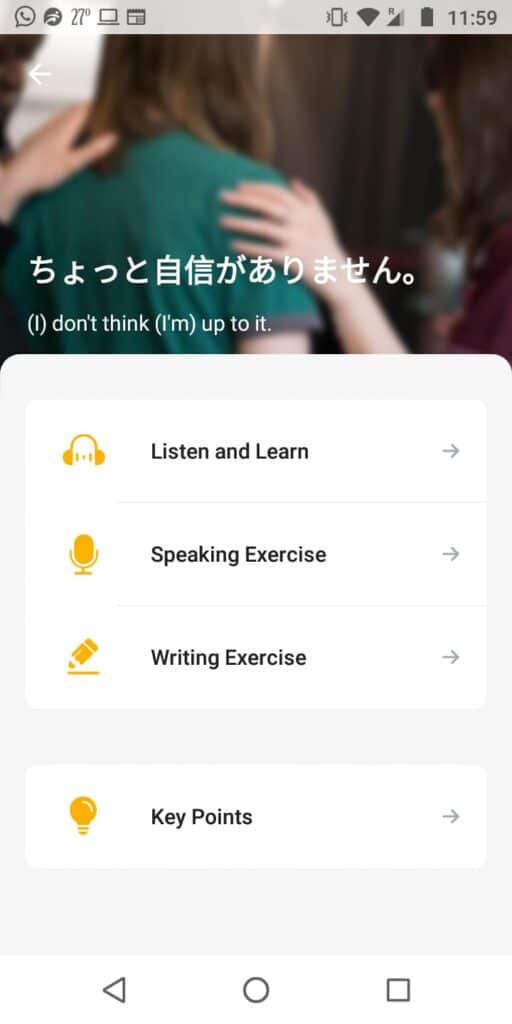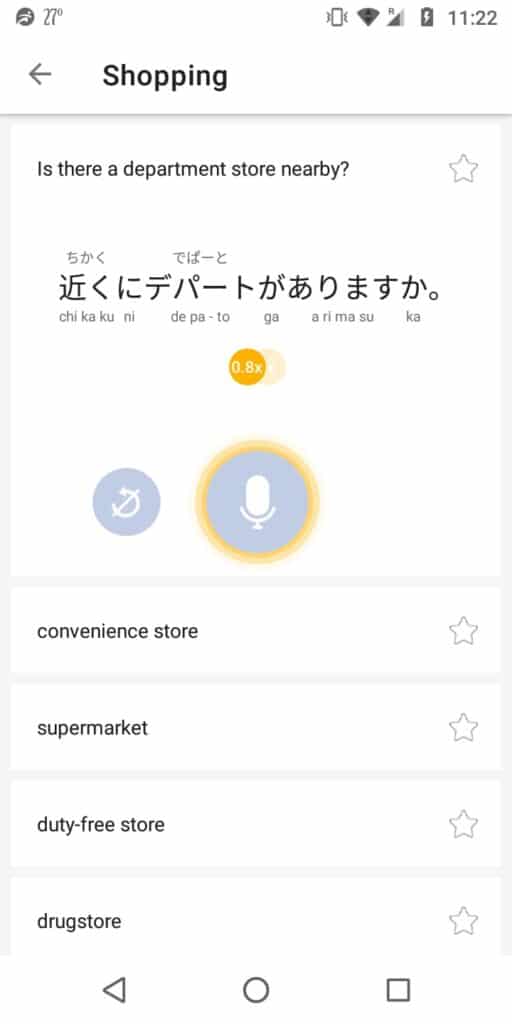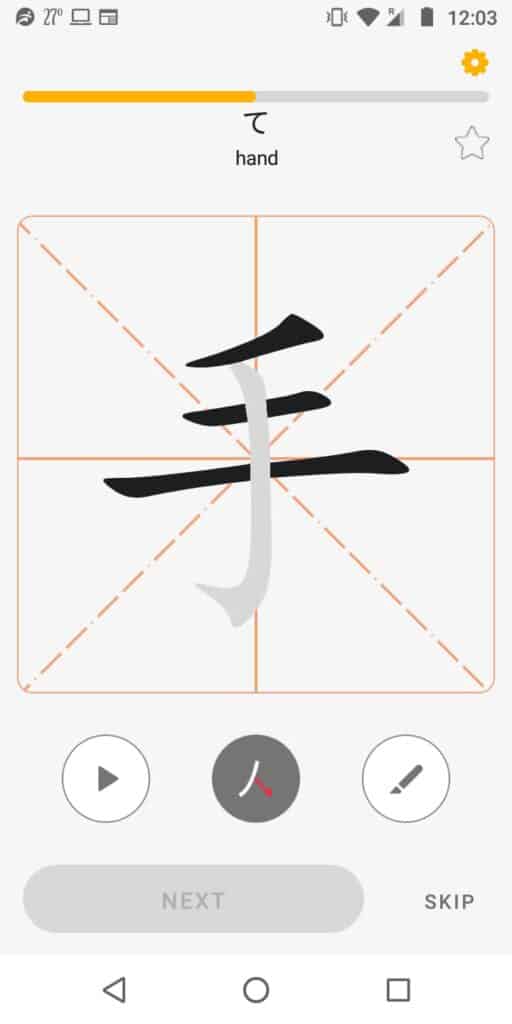
Complete LingoDeer Review for 2024: Fun and Effective but Lacks Authentic Content and Video
LingoDeer promises a complete education in several languages. So I tried the app for one week to see if it could help someone with no Japanese skills to learn the language to any level of competency.
What I found was that, yes, I did start learning Japanese quickly with LingoDeer. I loved the native audio, well-designed courses and straightforward grammar explanations. But at the same time, a few things were missing for me, such as the lack of authentic content and speaking practice.
Overview

Name: LingoDeer
Description: An app that provides a user-friendly introduction to the complex aspects of language learning.
Languages offered: Korean, Japanese, English, Chinese, Spanish (Castilian and Latin American), French, German, Thai, Portuguese, Russian, Italian and Vietnamese.
Offer price: Monthly subscription from $14.99/month up to a one-time fee of $159.99 for lifetime access
Summary
LingoDeer aims to teach the whole language to beginners, not just its components. It does this through expert-created lessons that don’t shy away from difficult topics like grammar explanations. Although it lacks video and audio content, and has no opportunities to speak, the app will set you up with a strong understanding of your target language at the beginner level.
- User friendliness - 8/108/10
- Delivers on promises - 9/109/10
- Authenticity - 5/105/10
- Value for price - 7/107/10
Pros
- Native audio in all courses
- Well-structured lessons
- Excellent grammar explanations
- Offline learning
- Fantastic review system
- Free travel phrasebook
Cons
- Not all courses include all the features
- No video material or authentic content
- No content for advanced learners
- Little speaking practice for non-Asian languages
- You have to pass previous “Test Out” quizzes to access later lessons
- Each app needs a separate premium subscription
Contents
- What’s LingoDeer?
- How Much Does LingoDeer Cost?
- What to Expect: LingoDeer’s Main Features
- The Pros of LingoDeer
- The Cons of LingoDeer
- LingoDeer Versus Other Language Learning Programs
- The Final Verdict
Download: This blog post is available as a convenient and portable PDF that you can take anywhere. Click here to get a copy. (Download)
What’s LingoDeer?
LingoDeer is a comprehensive language-learning platform.
Born as an app specializing in teaching Asian languages, you can now use it both as an app and on your computer to learn up to 12 languages: Korean, Japanese, English, Chinese, Spanish (Castilian and Latin American), French, German, Thai, Portuguese, Russian, Italian and Vietnamese.
You can also choose the language of instruction for each language. For example, if you want to learn Japanese and your native language is Spanish, you can.
I opted for the Japanese course taught in English.
How Much Does LingoDeer Cost?
LingoDeer gives you the following features for free:
- The alphabet section
- The first couple of lessons
- A phrasebook
- A review feature
- For some languages, a section to improve your conversation skills and a section to practice writing characters.
If you want to get access to all the content it has (and learn all the languages available), then you have to buy a Premium plan.
Starting at $14.99 a month, or you can opt to buy lifetime access for $159.99. Here’s a link to Lingodeer’s pricing page.
What to Expect: LingoDeer’s Main Features
LingoDeer has a lot to offer. Let’s have a look at its main features.
App and Browser Availability
As I’ve already mentioned, LingoDeer can be used as an app on your phone (both iOS and Android devices) or as a web language learning method.
If you have a premium plan, you can use it across all your devices and sync your progress.
Well-structured Courses
LingoDeer’s courses have been carefully designed by language teachers and are very well organized.
I’m a language teacher myself, so I know course organization is crucial.
LingoDeer seems to know what it’s doing in this sense.
The courses are divided into different levels of expertise. Each level covers several everyday topics and each topic includes a few lessons.
The courses have a grammar skeleton that gets support from vocabulary, exercises, explanations, sample sentences and audio, among other features (as you’ll see below).
Every language has lessons covering everything up to the intermediate level.
Native Audio
Listening to native speakers of the language you’re learning is one of the best ways to get a good accent and practice your listening comprehension and speaking skills.
LingoDeer offers HD native audio for all its languages from the very first letter to the last sentence.
Learn Tab
A big chunk of the material available for each language has been placed in this section.
When you access it, you’ll notice several things, some more obvious than others:
Alphabet
The alphabet section is naturally the first I always go to when I start learning a language.
I had no idea of how Japanese actually works, so it was very useful to have a place to learn all the hiragana and katakana characters with their romaji transcription.
I also got a very useful alphabet chart.
All the languages in the app include a very complete alphabet section with explanations, examples and native audio. If you’re just starting to learn a language, make sure this is the first place you visit.
Lessons
Each level of every course includes several useful topics. The first ones for Japanese are Nationalities, Profession and People, but the Spanish course starts with Greetings, Introductions and Family, and the Russian one with Fruit, Occupations and Questions.
All in all, the languages cover more or less the same topics in a different order or under different names, but the structure of the lessons is identical.
For each topic, you get two main sections: “Learn by doing” and “Practice makes perfect.”
The “Learn by doing” section is where the actual lessons are.
Each topic includes two or three lessons, and each lesson introduces around five to seven new words and phrases.
With the help of audio, cute animations and pictures, sample sentences and different types of exercises, by the time you’ve completed the lesson, you’ll have easily memorized its content.
The exercises included in each lesson are very varied. You get:
- Fill-in-the-blanks
- Choose the correct answer
- Choose the right image
- Translation
- Listening comprehension
- Putting words in order
- Typing
Depending on the language you’re learning, you’ll also get other types of exercises, like choosing the right character, tapping wrong words or adding words to their correct place in the sentence.
Two features I especially loved in the lessons were the audio speed selection (very useful when you get whole sentences) and the mic/ear buttons (perfect to record yourself and then listen to your recording).
And, like many competing apps, each lesson takes around five minutes to complete, so if you’re in a hurry or want to practice micro-learning, this is your app.
The “Practice makes perfect” section includes further reading, listening and speaking practice (especially in the form of dialogues, stories and full sentences you’ll have to listen to and record by yourself), as well as a subsection with tips.
Learning Tips
This is where you can read everything about the topic of the lesson, the explicit grammar rules and lessons that you need to know to perfect a new language.
Grammar is presented in a very understandable way so that learners can manage it by themselves. The examples included and the extensive explanations make grammar topics very digestible and easy to grasp.
This section also includes notes on vocabulary, pronunciation (with audio), language usage information and even cultural tidbits that will come in handy if you happen to visit a country where they speak the language you’re learning.
Test Out Feature
Every few lessons, there’s a test you have to take to make sure you’ve understood everything so far.
This test is a key to open the next batch of lessons for you.
What’s interesting about the “Test Out” feature is that you can take these tests even if you haven’t done the lessons.
This is fantastic if you’ve studied the language previously and don’t want to waste time revisiting topics you know well.
The problem is you have to pass all the tests up to the lesson you want to start with.
For instance, I wanted to have a look at the last group of lessons of the Japanese course to see what I was heading towards, but to do that, I had to take the 10 tests included in the intermediate level of the course.
Nevertheless, the Learn tab as a whole is LingoDeer’s most powerful weapon.
It’s well organized, very thorough and full of content and practice opportunities for learners.
I was very impressed by the amount of Japanese I could learn in just a few lessons. It took me a couple of days to learn the whole alphabet chart, and by day three, I was already saying my first few short Japanese sentences!
Review Tab
I also loved LingoDeer’s review system.
When you tap or click on the tab, you enter a whole new world divided into different sections.
Depending on the language you’re learning, you’ll see two (Vocabulary and Grammar) or three categories (Characters, Vocabulary and Grammar).
Characters is where you review characters if you’re learning languages such as Japanese or Chinese.
Vocabulary is where all the words you’ve learned so far can be revisited, and Grammar is where you can find the grammar rules you’ve covered in the lessons.
There’s also a section where you can take a 5-minute quiz that will quickly tell you if there’s any word or grammar rule you have to study again.
The tab also includes Knowledge Cards, which are cards that summarize the content of each lesson in a few lines.
Fluent Feature
Only available for Japanese, French, Spanish, Korean and Chinese right now, the “Fluent” feature can be used to improve your conversational skills.
It includes dialogues with audio, as well as speaking and writing exercises. There’s also a subsection called Key Points with explanations, grammar and sample sentences with translation.
Free users have access to only a couple of “Fluent” topics. The rest can only be accessed by premium students.
Travel Phrasebook
The travel phrasebook is one of the free treats LingoDeer offers.
With hundreds of words, expressions and full sentences on topics such as introductions, food & drink, health, shopping or dating, among others, this phrasebook can be used to get ready for your next trip or during it to communicate with the locals.
It’s actually a very complete and useful free resource, although some languages, such as Japanese and Chinese, include much more information than the rest.
Character Drill Feature
Only available for Japanese and Chinese, this feature is fantastic for learners who want to learn how to draw Japanese and Chinese characters like pros.
The Japanese course teaches you how to write 100 frequently used Kanji characters, while the Chinese course includes 1,000 essential characters.
The Pros of LingoDeer
I really enjoyed using LingoDeer, and as I said above, I was speaking entire (simple) Japanese sentences by the end of my first week using it. I’d call that a win. Here’s what else I really liked about LingoDeer:
- Native audio in all courses
- Japanese and Chinese character writing practice
- Well-structured lessons
- Excellent grammar explanations
- Offline learning option
- Fantastic review system
- Free travel phrasebook
The Cons of LingoDeer
Even though I liked LingoDeer overall, there were some areas for improvement in my opinion. The top cons to LingoDeer, for me, were:
- Not all courses include all the features
- No video material or authentic content
- No content for advanced learners
- Little speaking practice for non-Asian languages
- You have to pass previous “Test Out” quizzes to access later lessons
LingoDeer Versus Other Language Learning Programs
Since LingoDeer is conceived as a holistic language learning program, you’re supposed to be able to use it and it alone to achieve fluency. So I thought I’d see how the program matches up to three of my favorite language learning programs.
LingoDeer vs. FluentU
Since one of the features I most missed while using LingoDeer was video and authentic materials, I wanted to start this comparison section with FluentU, which has video at the heart of its program.
I know many people who’ve told me that they learned English through watching movies and TV. In fact, I’ve heard it so many times, I definitely believe it. So I like to use this method, too.
FluentU works really well for me because I’m a person who really likes to watch TV, movies, music videos, news and vlogs on YouTube. So it feels like a really sustainable and fun way to learn and review a language and it’s worked really well for me.
I find myself spending hours on FluentU, all while feeling engaged, while a 10 minute session on LingoDeer and other programs sometimes feels like a slog.
Overall, I think FluentU and LingoDeer would complement each other nicely, and the cost would still be pretty affordable.
LingoDeer vs. Duolingo
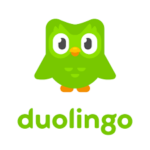
Comparing LingoDeer to Duolingo, Duolingo also has some more unusual languages, with choices such as Finnish, Hawaiian, Navajo, Ukrainian and Hebrew on offer.
I think that Duolingo is more a little fun and more gamified, and that cute little bird is always encouraging you (some would say pestering you), but especially for people studying Asian languages, LingoDeer might feel like a better fit because you get to practice writing Japanese and Chinese characters.
Here’s our full review of Duolingo.
LingoDeer vs. Ling

Ling, which is based in Thailand, has the same stated goal as LingoDeer: to teach the words, phrases and sentences that you really need in a language. Ling also uses spaced repetition just like LingoDeer, and both of the programs are based in Asia.
Ling has a lot of less common languages like Nepali, Mongolian, Lao, Bosnian, Latvian and more. Overall, there are 60 languages currently on the program.
But I found myself confused by some of Ling’s example sentences and word choices. I thought to myself: would I ever say this? No. They’re often too formal, or just not useful.
Also, Ling doesn’t teach the writing system of the languages that use them. If you can’t read Thai, for example, you’re going to be very lost as a beginner, and there’s no Japanese and Chinese character writing practice like on LingoDeer.
The Final Verdict
Will LingoDeer help you learn a language? Yes, it will!
The organization of the courses allows students to learn up to the B2 level. The lessons have been created by people who know what they’re doing, and all the supplementary practice works nicely with the main content to create an effective whole.
Is LingoDeer worth its price? It definitely is, but…
Having two main apps (three if you also want the children’s English learning app) and making learners buy two independent premium plans is a bit excessive.
If a premium subscription gave students unlimited access to both adult-oriented learning apps, LingoDeer would be practically unbeatable.
Does LingoDeer have everything a learner needs to reach fluency in a language? Unfortunately, it doesn’t.
There are some things missing in the app.
The lack of authentic content and video material is its biggest flaw. Besides, advanced students can skip this app altogether, since there’s absolutely no material for them.
Thankfully, other language learning platforms such as FluentU contain a vast treasure of resources covering these two key aspects.
With FluentU, you hear languages in real-world contexts—the way that native speakers actually use them. Just a quick look will give you an idea of the variety of FluentU videos on offer:

FluentU really takes the grunt work out of learning languages, leaving you with nothing but engaging, effective and efficient learning. It’s already hand-picked the best videos for you and organized them by level and topic. All you have to do is choose any video that strikes your fancy to get started!
Each word in the interactive captions comes with a definition, audio, image, example sentences and more.
Access a complete interactive transcript of every video under the Dialogue tab, and easily review words and phrases from the video under Vocab.
You can use FluentU’s unique adaptive quizzes to learn the vocabulary and phrases from the video through fun questions and exercises. Just swipe left or right to see more examples of the word you're studying.

The program even keeps track of what you’re learning and tells you exactly when it’s time for review, giving you a 100% personalized experience.
Start using the FluentU website on your computer or tablet or, better yet, download the FluentU app from the iTunes or Google Play store. Click here to take advantage of our current sale! (Expires at the end of this month.)
In general, my final verdict is: LingoDeer is a powerful app that’s definitely worth a try.
Stay curious, my “deer” friends, and as always, happy learning!
